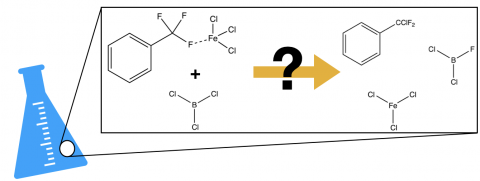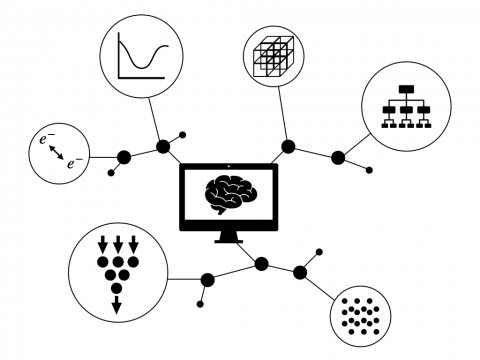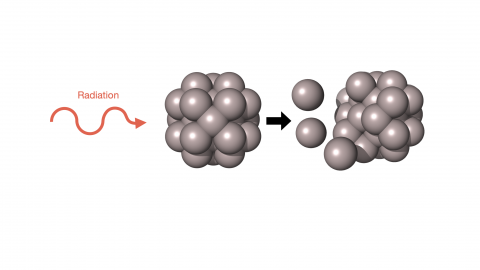
If these interest you, please book a meeting or try to do a rotation with our group.
- If you're a synthetic chemist, please look at Project 1 in particular!
- If you're a physical chemist, please look at Projects 2 and 3.
Emails can be found on the people page! Feel free to ask questions by emailing us.
Project 1: Using calculations to inform experiments

Computational chemistry projects are not limited to those who identify as “physical chemists”. Computational data is used in (nearly) every discipline of chemistry, and computer-based chemistry careers are becoming more prevalent as technology develops. Many computational chemists work closely in collaborations with synthetic chemists because theoretical models can provide additional information that cannot be obtained in experiment, such as the distribution of molecular orbitals in a transition metal complex. Learning how to use computational chemistry to support experimental findings also allows you to learn more about the synthetic experiments from a different perspective.
We are looking for a chemist with a synthetic (i.e. inorganic, materials, solids) background to join our group to develop and study computational models of experimental phenomena. We are interested in the understanding of how and why certain chemical phenomena occur. We are interested in developing theoretical models of nanoparticles, quantum dots and inorganic solid-state materials.
A new graduate student in the group will have the following responsibilities:
- Learn to perform calculations on model systems with two or more programs
- Provide insight/understanding of experimental processes involved in the phenomena being studied
- Read literature around the project topic, both theoretical and experimental
- Work with experimental collaborators to develop appropriate models, as needed
For this project you will need a strong background in one branch of chemistry other than physical chemistry. Willingness to go outside your comfort zone. No programming experience.
Funding for this direction will come from an active National Science Foundation grant.
Project 2: Machine learning to speed up calculations of solids

We are trying to find ways to solve the Schrödinger equation for the electrons in a molecule. We can use machine learning to learn the wavefunction of small systems that can be treated with little to no approximations, and apply this to large systems that require many approximations which introduce error. This lowers the cost of calculations (in terms of human time and money) and is of importance to a wide range of applications in academia and industry. We are looking for a highly motivated student to use a variety of machine learning models in Python.
Machine learning is often used to recognize where hidden patterns are in large data sets, where human bias can sometimes interfere with reaching conclusions. It has been successful in predicting trends in the periodic table, in electronic configurations, and even geometries of molecules with small amounts of prior information. We would like to see if there are similar benefits for our simulations of solids. There are a variety of machine learning frameworks that each have their own pros and cons. Which methods work best in quantum chemistry is still an open question. As such, it is worthwhile to scan across different methods, and see which is the optimal model for our systems.
A new graduate student in the group will have the following responsibilities:
- Be willing to learn (self-study, from peers, from advisor) programming
- Run calculations on a variety of solids from molecular drug molecules to metals
- Work with collaborators/expert consultant to advance different parts of project
For this project you will need: Openness to learn programming (no prior experience is required). Enthusiasm to use computers to solve chemical problems.
Funding for this direction will come from an active National Science Foundation grant.
Project 3: Radiation damage to metals

Quantum chemistry can be used to understand what is going on inside of a chemical reaction, and computer simulations allow us to better understand the breaking and forming of bonds within molecules. Models for chemical bonding and molecular orbitals are routinely used by chemists from all disciplines. These days, computers can be used to solve the quantum mechanics involved in determining what bonding models and structures accurately fit what is happening in experiments since it’s not always possible to see these mechanisms directly in the lab.
We are trying to research the stability of transition metals, such as gold, platinum, and copper, when subjected to high levels of radiation from lasers. To do this, the metal has to be modeled as a cluster and the chemical identity of the atoms varied. We would be looking for evidence that d-orbital transitions cause degradation of the surface. Improving understanding of the properties of these metals could help in research such as cancer treatments that involve irradiating nanoparticles.
A new graduate student in the group would be trained and have the following responsibilities:
- Set up and run calculations.
- Apply methods being developed in the group to test systems.
- Engage as part of a team involving experimental collaboration.
Enthusiasm to use computers to solve chemical problems is a requirement. The prior knowledge required for this project from undergraduate is General Chemistry/Principles of Chemistry.
Funding for this direction will come from an active Department of Energy grant.